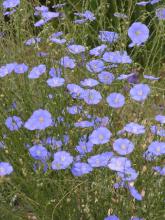
High Plains Gardening
The gardening website of the Texas High Plains Region

Linum lewisii, the southwestern and western native perennial wildflower variety of flax was named after Meriwether Lewis, who was first to describe it during the Lewis and Clark Expedition. On July 18th, 1805, near the Great Falls of the Missouri Lewis recorded: "I have observed for several days a species of the flax growing in the river bottoms the leaf stem and pericarp of which resembles the common flax cultivated in the U'States. The stem rises to the hight of about 2 1/2 or 3 feet high; as many as 8 or ten of which proceeds from the same root. The root appears to be perennial." Lewis collected seeds a month later. However the original cache of seeds was destroyed by floods; he doubtless collected more, as Bernard McMahon (who was given seeds to grow from the expedition) reported to Thomas Jefferson that he had success in growing the new perennial flax. This blue flax was given the botanic name Linum lewisii a few years after Lewis' death.
Hundreds of delicate sky blue flowers, not more than an inch in diameter, will adorn one plant during the season, each lasting only a day. Self-seeding will occur, but not enough to be a nuisance. Any unwanted plants are easily pulled or transplanted when young. Its main bloom period is during the summer, but with adequate moisture, limited blooms will continue. Its blue flowers will be morning bloomers, similar to other native prairie wildflowers like the Oenotheras, unless the day is cloudy.
A wide range of bees and flies are pollinators. The fibers were used by the Klamath Native Peoples in making baskets, mats, and fish nets. Flax seeds were used in New Mexico as a poultice to treat infected wounds, and to reduce swelling and boils.
Other native flax are the L. rigidum, yellow flax and our native blue flax, L. pratense (an annual). L. grandiflorum ‘Rubrum’, a red flax is available as well.
The annual flax, Linum usitatissimum, is the cultivated flax used for fiber (stem) and linseed oil from its seeds.Although our native flax has no commercial value, it is of great value to the home garden. A short lived perennial, blue flax should be part of our low water-use garden. L. perenne is native to Europe (some call it an annual). Sometimes our native perennial blue flax is given the name L. perenne var. lewisii. Nearly all the literature describes L. perenne var lewisii as a US western native plant.
Companions to blue flax are California poppies, chocolate flower, Calylophus, Blackfoot daisy, and Salvia greggii, Furmans Red. Sunny bed or border, near the front middle area. Xeriscape bed, xeristrip. Native plant garden.
In early spring, thin out seedlings, or transplant them. Trim out dry spent stems in mid to late summer.